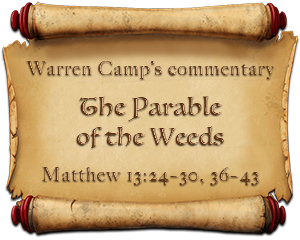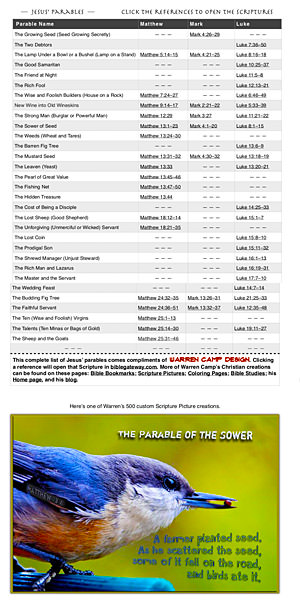Jesus’ parable of weeds among wheat presents the kingdom of heaven as being like a farmer who sows good wheat seeds but is surprised to find that the seed collection seems to have contained seeds that developed into weeds. The weeds and the wheat must be allowed to grow together until the time of harvest, because, like a mustard seed or like yeast, the kingdom of heaven will grow and expand.
Because his disciples didn’t fully understand his allegory of seeds, wheat, and weeds, he explained it to them when they asked for clarification.
— Preview —


Click the list or the “bird” to enlarge and use Warren’s list of forty-four of Jesus’ parables (a PDF file with links to Scriptures).
par•a•ble [noun] a simple story used to illustrate the meaning of or a moral or spiritual lesson, as told by Jesus in the gospels
synonyms: allegory, moral story/tale, fable
Jesus’ Parable of the Wheat and the Weeds (the Tares)
Matthew 13:24–30, 36–43
Today’s parable follows the Parable of the Sower, the Seed, and the Soil (Matthew13:1–23), which we covered in this summary. That parable presents how, when God (the “sower”) presents and sows his Word (the “seed”) on a variety of types of people (the “soil”), we can expect to see different results; some people will cultivate much from the growth of God’s Word in their lives, while many will be unable to see the seed take root.
This Wheat and Weeds parable is similar to the previous one, but only to the extent that seed had been sown. Every other element holds a different meaning and takes us to a sobering conclusion about God’s field and those who live in it. Specifically, this follow-up weeds parable (also known as the Parable of the Wheat and the Tares and the Parable of the Weeds) — highlights the work of the enemy in people’s lives (“grain fields”). It’s filled with spiritual significance and truth. The first passage of this two-part parable introduces us to what Jesus has said to a crowd of followers, while the second passage provides Jesus’ clear explanation of it to his disciples.
In addition to this “weeds” parable, Jesus presented six well-known agriculture parables about seeds, vineyards, and trees: the Parable of the Seed, Soil, and Sower, the Parable of the Growing Seed, the Parable of the Mustard Seed and Yeast, the Parable of the Workers in the Vineyard, the Parable of the Budding Fig Tree, and the Parable of the Barren Fig Tree.
Jesus speaks the “Parable of the Wheat and Tares” to the crowd (Matt. 13:24–30, 36–43).
The Wheat and Weeds Parable
A Story about the Work of the Enemy — Satan
Part 1 — Matthew 13:24–30
Because Jesus lived in an agrarian society, it shouldn’t surprise us that his many parables use metaphors related to farming. When he told these stories to people, his audience would have resonated with words about fields, seeds, and crops. He effectively used tangible ideas to describe and illustrate the mysterious and subversive nature of the worldly kingdom. It’s in our kingdom, here in this world, that the enemy — Satan — strives to bring evil into everyone’s lives.
Jesus tells a very interesting and rather mysterious story about a wheat farmer who has an enemy — one who stealthily sows weeds in the dead of night. That alone is intriguing, but things get even more interesting when the story concludes with a rather surprising twist in terms of how the farmer reacts to the agricultural mischief of this mysterious enemy.
The story raises many questions: What does it mean? What do the weeds stand for? Who’s the enemy? And why not judge good from bad by weeding the wheat field the same way many of us weed our flower and vegetable gardens?
This parable’s point: God’s judgment. He’s to be the judge who’ll determine good from bad, true from false. It’s the Lord God, not us, who’ll make the final determination and final separation.
These twenty verses of Jesus’ parables are broken into two parts: In the first part (vv. 24–35), he tells three parables to a crowd of interested followers, including his many disciples: the Parable of the Weeds (vv. 24–30) and the brief Parables of the Mustard Seed and the Yeast (vv. 31–35). The second part of today’s passage covers Jesus’ clear explanation to his disciples of the meaning of the Parable of the Weeds (vv. 36–43).
The Presentation This opening passage presents a simple picture: One field with two sowers. In the field, one person sows good seed while the other sows weeds or “tares.” A tare is a plant that commonly grows in grain fields. Although it looks similar to edible grain, it’s not suitable as food. Many theologians feel that the tare or weed referred to in this parable is darnel, a poisonous weed that resembles wheat. Darnel that grows next to wheat stalks cannot be easily distinguished from real wheat. It’s not until harvest time when the kernels are ripe that a farmer can discern which is wheat and which is weed.
In this parable, an enemy snuck into a farmer’s field and sowed weeds — tares — among the good wheat. The roots of wheat and darnel so intertwine that they can not be separated without pulling up both. Roman law prohibited sowing darnel among the wheat of an enemy, suggesting that the scenario presented here is realistic.
Let’s follow the text’s progression: “a man sowed good seed in his field” (v. 24); “while everyone was sleeping, his enemy came and sowed weeds among the wheat, and went away” (v. 25); “both grew together until the harvest” (v. 30a); “the weeds were collected and tied in bundles” (v. 30b); “the wheat was gathered and brought into my barn” (v. 30c); “weeds will be separated and thrown into blazing fire” (v. 42) while “the righteous will shine like the sun in the kingdom of their Father” (v. 43).
Here’s a simple summation of Jesus’ Parable of the Weeds among the Wheat: Some people believed wholeheartedly in Jesus while some didn’t believe at all. It’s not easy to know who trusted and followed Jesus. But one day, Jesus will come back to this world when he’ll separate those who fully trust him from those who don’t. The words that Jesus had said about people who didn’t believe in him or trust him are severe: “They will throw them into the blazing furnace, where there will be weeping and gnashing of teeth.”
Part 2 — Matthew 13:36–43
The Explanation This follow-up passage reveals to its hearers and us that the kingdom of God is mysterious. His disciples approached him in private where Jesus explained the meanings of (a) the field of the world, (b) the good seed who are the sons of the kingdom, and (c) the weed-like people who’ll face God’s final judgment. He then clarified who the two sowers of his parable were and what would happen to each seed type.
So, Who’s Who?
Jesus, the sower of seed, has a field, defined here as the entire world. He spreads his redeemed seed, i.e., true believers, onto the world’s field. Through his grace, these Christians bear the fruit of the Spirit. When the kingdom of heaven comes to its fruition, heaven will be a reality and there will be no “weeds” among the “wheat.” But today, both good and bad seeds mature in our world.
The enemy in the parable is Satan. In opposition to Jesus Christ, the devil tries to destroy Christ’s work by placing false believers and teachers in the world to lead many astray. But we’re not to pursue such people in an effort to destroy them. Instead of requiring these false believers to be rooted out of the world, possibly hurting immature believers in the process, Christ allows them to remain until his return when angels will separate true believers from false believers.
There is a divine meaning and purpose being worked out here. God is guiding history and mankind to an end that will fulfill his purpose. This parable is showing two different works being done in the world. And it provides understanding as to why there’s evil. God plants good seed that becomes his children of his kingdom; Satan, the wicked one, plants those who are his offspring.
Because the tares and wheat look alike, it’s virtually impossible to visibly determine which is wheat and which is weed. That’s why God tells his servants to let them both grow to harvest when the difference will become apparent. Are the “sons of the wicked one” who are among them truly evil people? Not always. The parable tells us that they look and act similar to “the sons of the kingdom,” yet cannot be told apart.
Satan is the god of this age. He actively attempts to keep everyone deceived. And he can infiltrate the closest quarters of God’s people. Jesus’ words to this effect should serve as a warning.
Judgment in a Matter of Time — God’s Time
We learn from this parable that patience is a virtue. If the servants of the field owner had rampaged through the fields, tearing up the tares among the good wheat, the harvest would have been significantly compromised. Good growth would have been prevented from coming to maturity and bearing fruit. So it is with working in God’s spiritual field and in his church. It’s very possible to harm, even destroy, the good when employing efforts to weed out tares.
God says to let both types grow together until the harvest — the end of the age — when Jesus Christ returns. He’ll then make a distinction, a judgment, that only he can make. The modern world doesn’t like to hear the word “judgment,” which implies that there are moral and ethical standards and laws to be followed. But God says that there will come a time of judgment that will deal with lawlessness and unrighteousness. The key is that it’s God’s judgment, not man’s. That’s a wonderful and comforting truth because God judges in perfect righteousness and in his appropriate time.
A Hearty Way to Apply This Parable Today
At the heart of this story about the weeds and the wheat, Jesus is clearly telling us that there will be a final judgment and a final separation of good people from bad. His clear revelation about the final judgment is meant to motivate us to live godly lives that would please God, stimulating us to be the kind of people God wants us to be. While such “threat of hell” motivation certainly isn’t politically correct, it’s still real.
A second theme that we ought to hear in this parable of Jesus is that only God is to judge; we human beings are not to see ourselves as the judge. It’s God’s responsibility to make the final judgment calls.
Only God knows. He’s the only one who can see inside a person and realize what lies beneath the sheen and shine of one’s life. And besides, there will be a lot of surprises on judgment day.
In this parable, Christ concludes by saying, “He who has ears to hear, let him hear.” It’ll be wise for us to hear his teaching, letting it move us in godly fear to live soundly and faithfully.
“They will throw them into the blazing furnace, where there will be weeping and gnashing of teeth” (Matt. 13:42).

